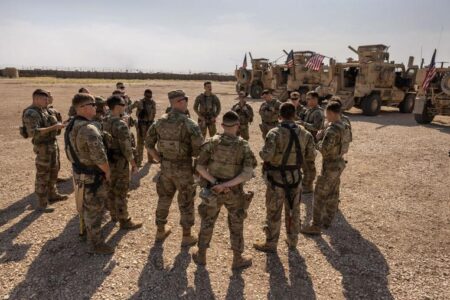
The U.S. military plan to keep ISIS down
The focus may be on the midterms and the Russia-Ukraine war, but the Pentagon is quietly starting to build infrastructure in Syria for a long-haul fight with the Islamic State.
Roughly 900 special forces are still working overtime to help local forces hunt ISIS remnants to keep the terrorist group at bay. The Department of Defense’s latest weapon of choice, though, is improved facilities and services so ISIS can’t break out the 10,000 or so former fighters languishing in crumbling detention centers across Syria.
ISIS fighters have targeted these areas multiple times in recent months, most brazenly attacking the Hasakah prison in northeastern Syria in January. Scores of prisoners escaped during the 10-day battle that ensued.
“We know that ISIS sees the detention centers, the detainee population, as the path to reconstitute its ranks,” said one defense official, who was granted anonymity to speak candidly about the situation. “So even though ISIS doesn’t hold territory… the inspiration and the will to reconstitute is not going away.”
The Pentagon sought authority and funding from Congress to make some improvements, although it’s the local partner — the Syrian Democratic Forces — that is actually carrying out the upgrades on the ground.
Some of this work has already begun, including building guard towers and installing lights to prevent nighttime smuggling. The ultimate goal is to build new, purpose-built facilities that are more secure and humane, with access to medical and other services. DoD is doing feasibility assessments for the construction of these new facilities, though the effort is expected to take several years.
But this is a Band-Aid to a much deeper problem. The long-term solution, officials say, is repatriating the prisoners to their countries of origin — primarily Iraq, Syria and a number of other nations including Canada and Australia. Unfortunately, the outlook is pretty grim.
“If the repatriation efforts continue at this rate, we will be there for a decade or more,” the official said. “So, the urgency of this problem, for which the State Department is in the lead, couldn’t be more dire.”
Any progress the U.S. and its partners are making in the country, though, could be impeded by another large-scale Turkish invasion of northeastern Syria.
Ankara has been making noises about such an incursion for months, while at the same time raising tensions by conducting strikes in Syria against Syrian Democratic Forces targets, including taking out the female leader of the YPJ, the all-female arm of the SDF.
U.S. officials have raised the alarm since the summer that such a move would be catastrophic for the counter-ISIS fight. Top defense officials even visited Turkey earlier this year to convey their concerns directly to Ankara.
Source: Politico





